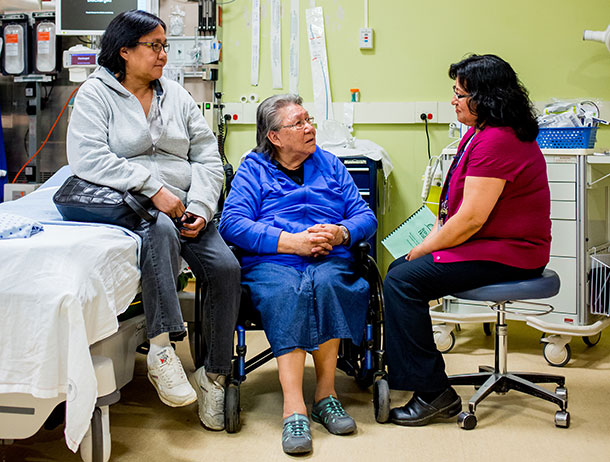
THUNDER BAY – The life expectancy rates for those living in northern Ontario continue to be lower and mortality rates higher than the rates in the province overall, according to a new report by Health Quality Ontario, the provincial advisor on the quality of health care.
“Despite many improvements in health and health care across the province in recent years, there are stubborn and persistent inequities in the care people receive in the north, and in their health outcomes,” said Dr. Joshua Tepper, President and CEO of Health Quality Ontario.
Health in the North: A report on geography and the health of people in Ontario’s two northern regions sheds light on the differences between people in Ontario’s two northern Local Health Integration Network (LHIN) regions and those living in the rest of Ontario, and how attempts are being made to address these inequities.
The report focuses specifically on the area of the North East and North West LHIN regions that extends north of Lake Huron to Hudson Bay and James Bay, and from the Quebec border in the east to the Manitoba border in the west. This region covers nearly 80% of Ontario’s landmass, and has a combined population of over 800,000.
Key findings from the report:
- People in Ontario’s north have a much shorter life expectancy than those in the province overall – 2.9 years lower than Ontario in the North West LHIN region and 2.5 years lower in the North East LHIN region.
- People in the north are more likely to die prematurely (before age 75) due to suicide, circulatory disease and respiratory disease.
- People in the north are much less likely to report being able to see a family doctor, nurse practitioner or other regular health care provider when needed.
- People in the north are more likely to report having multiple chronic conditions.
Many of these inequities can be attributed to systemic challenges faced by health care professionals and the many challenges involved in serving a population spread over such a wide area with a low population density, including many fly-in communities. Inequities are also the result of many variables beyond the health care system known as the social determinants of health.
In the report, Pierre, 71, a double-lung transplant recipient who lived in Nakina, a village north of Thunder Baywith his wife Suzanne, tells his story about how tough it was to travel for the health care he needed, and to pay for accommodation and medication expenses. “I had to move to Thunder Bay and travelled five or six times back and forth to Toronto,” says Pierre. “My wife drove there. It took about 20 hours every time. Twenty hours when you’re sick was really tough.”
The report also details the specific challenges Indigenous and francophone populations face in the north.
Nearly one in five people (18.3%) identify as Indigenous in the North West LHIN region and more than one in 10 people (11.0%) in the North East LHIN region, compared to 2.4% in Ontario overall.
Over the last several decades in Ontario (and across Canada), Indigenous peoples have faced discriminatory policies that have affected health, including forced relocations and residential schools. Differences in the way health care is funded and delivered for First Nations, Métis and Inuit people in Ontario also mean performance measures may not represent their experiences as well as they do for the general population of the northern regions.
“The solutions to the inequities facing people in the north need to be found in the north by those who live and work there,” said Dr. Jennifer Walker, Canada Research Chair in Indigenous Health at Laurentian University and a member of the Six Nations of the Grand River. “Solutions cannot simply be imported from the southern part of the province. The landscape – social and cultural as well as geographic – is totally different.”
In the report, Marlene, a Métis community member, shared significant challenges in accessing care: “We don’t have the support for medical transportation that is available for First Nations through the federal programming,” she said. “We have to rely on family and friends, and on volunteer drivers from our Métis community. I’ve known Métis community members who miss treatments and forgo getting the care they need because they just can’t get there. They do without.”
There are large francophone populations in the North East LHIN region, and smaller but significant francophone populations in areas of the North West LHIN region. More than one in five people (21.6%) in the North East LHIN region identify French as their first official spoken language, which is more than five times the Ontario rate of 3.9%.
In the North West LHIN region, 45% of the francophone population perceive their health as very good or excellent, compared to 62% of the overall francophone population in Ontario. To avoid language barriers in health care, the francophone population needs to have health services available to them in French, the report states.
Despite these challenges, there are several region-specific efforts underway to improve access to care for people living in the north. Examples include:
- Aboriginal Health Access Centres to provide a place of safety and belonging for First Nations, Métis and Inuit people.
- Development of an action plan by the North East LHIN in response to the Truth and Reconciliation Commission report.
- Some Community Health Centres focus on, or prioritize, the needs of Indigenous peoples and of francophones.
- A range of health services and supports offered by the Métis Nation of Ontario.
- Telemedicine and virtual critical care services to help people manage disease and critical illness, and mobile services to deliver care to patients where they are.
- A provincial travel grant program helps patients get to the care they need when it is unavailable in their local communities (at least a 100 km).
- Language services to enable doctors, nurse practitioners and other health providers to effectively communicate with patients who speak other languages.
- Personal support services to assist patients after discharge from hospital and help with everyday tasks.
- Focused medical education: The Northern Ontario School of Medicine recruits students from Indigenous, francophone, and small communities in the north. The majority of its graduates remain in northern Ontarioto practice.
“These initiatives demonstrate the commitment of all of those working in the north to find solutions to the unique challenges they face,” said Dr. Walker.
Health Quality Ontario has developed a Health Equity Plan to encourage everybody involved in providing health care to consider equity prominently when developing plans to build a safe and patient-centred system.
This plan includes support for the development of a health equity strategy specific to northern Ontario. An initial meeting to launch this initiative was held in November 2016 and involved 70 representatives from health organizations in Sudbury, Thunder Bay and other northern communities.
The Ontario government launched the First Nations Health Action Plan in 2016 to ensure Indigenous people have access to more culturally appropriate care and improved outcomes, focusing on the north where there are significant gaps in health services. As part of Ontario’s response to the Truth and Reconciliation Commission, the Ontario government announced investments to expand access to Indigenous Mental Health and Addictions Treatment and Healing Centres and mental health and wellness programs.
To provide a personal perspective of the issues raised by the data in the Health Quality Ontario report, and to describe some of the circumstances unique to people living in the northern LHIN regions, the report also features stories from patients, caregivers and health care professionals in the north.
To read the full report visit: www.hqontario.ca/HealthintheNorth.






